
The Messerschmitt Bf 109 is a German World War II fighter aircraft that was, along with the Focke-Wulf Fw 190, the backbone of the Luftwaffe's fighter force. The Bf 109 first saw operational service in 1937 during the Spanish Civil War. It was still in service at the end of World War II in 1945. It was one of the most advanced fighters when it first appeared, with an all-metal monocoque construction, a closed canopy, and retractable landing gear. A liquid-cooled, inverted-V12 aero engine powered it. It was called the Me 109 by Allied aircrew and some German aces, even though this was not the official German designation.
13. Staffel (slowakisches) Jagdgeschwader 52 was a front-line unit of the Nazi Germany's Luftwaffe made up of Slovak personnel during World War II.
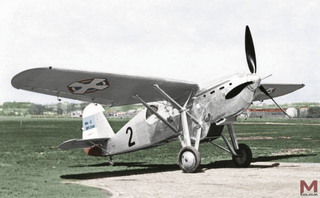
The Ikarus IK-2 was a 1930s high-wing, single-seat, monoplane fighter aircraft of Yugoslav design built for the Royal Yugoslav Army Air Force. The IK-2 was designed by French-trained engineers Kosta Sivčev and Ljubomir Ilić, who saw the desirability of developing a home-grown aircraft industry. A gull-wing design, it was armed with a hub-firing autocannon and fuselage-mounted synchronised machine guns. Just 12 production models were built, as the aircraft was obsolescent at the time it was brought into service in 1935, and only eight were serviceable at the time of the German-led Axis invasion of Yugoslavia in April 1941. After the defeat of Yugoslavia, the remaining four aircraft were taken onto the strength of the air force of the Axis puppet state, the Independent State of Croatia, but none survived the war.

The Rogožarski IK-3 was a 1930s Yugoslav monoplane single-seat fighter, designed by Ljubomir Ilić, Kosta Sivčev and Slobodan Zrnić as a successor to the Ikarus IK-2 fighter. Its armament consisted of a hub-firing 20 mm (0.79 in) autocannon and two fuselage-mounted synchronised machine guns. It was considered comparable to foreign aircraft such as the Messerschmitt Bf 109E and came into service in 1940. The prototype crashed during testing; twelve production aircraft had been delivered by July 1940.
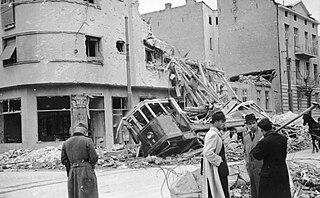
Operation Retribution, also known as Operation Punishment, was the April 1941 German bombing of Belgrade, the capital of Yugoslavia, in retaliation for the coup d'état that overthrew the government that had signed the Tripartite Pact. The bombing occurred in the first days of the German-led Axis invasion of Yugoslavia during World War II. The Royal Yugoslav Army Air Force (VVKJ) had only 77 modern fighter aircraft available to defend Belgrade against the hundreds of German fighters and bombers that struck in the first wave early on 6 April. Three days prior, VVKJ Major Vladimir Kren had defected to the Germans, disclosing the locations of multiple military assets and divulging the VVKJ's codes.

Marmaduke Thomas St John Pattle,, usually known as Pat Pattle, was a South African-born English Second World War fighter pilot and flying ace of the Royal Air Force (RAF).

The invasion of Yugoslavia, also known as the April War or Operation 25, was a German-led attack on the Kingdom of Yugoslavia by the Axis powers which began on 6 April 1941 during World War II. The order for the invasion was put forward in "Führer Directive No. 25", which Adolf Hitler issued on 27 March 1941, following a Yugoslav coup d'état that overthrew the pro-Axis government.
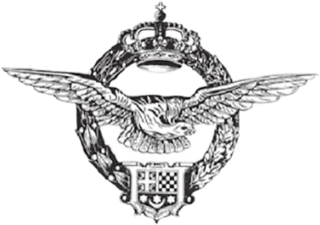
The Royal Yugoslav Air Force, was the aerial warfare service component of the Royal Yugoslav Army. It was formed in 1918 and existed until 1941 and the Invasion of Yugoslavia during World War II.

The Air Force of the Independent State of Croatia, was the air force of the Independent State of Croatia (NDH), a puppet state established with the support of the Axis Powers on the territory of the Kingdom of Yugoslavia during World War II. The ZNDH was founded under German authority in April 1941, following the German-led Axis invasion of Yugoslavia.
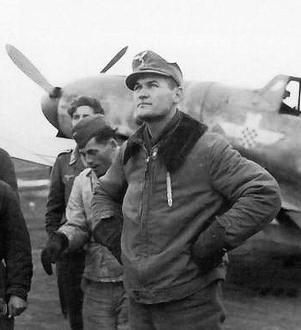
Mato Dukovac was the leading Croatian fighter ace of World War II, credited with between 40 and 44 confirmed victories. He joined the Air Force of the Independent State of Croatia following the Axis invasion of Yugoslavia in April 1941, and then the Luftwaffe, with which he flew combat missions on the Eastern Front. His tours of the Eastern Front spanned October and November 1942, February to June 1943, and October 1943 to March 1944. He defected to the Soviet Union on 20 September 1944 and was returned to Yugoslavia in November 1944. He worked as a flight instructor for the Yugoslav Air Force in Pančevo and Zadar before defecting to Italy in April 1945.
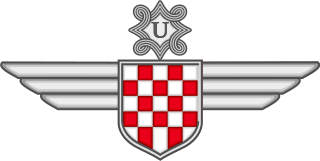
The Croatian Air Force Legion, or HZL, was a unit of the Luftwaffe, composed entirely of volunteers drawn from the nazi puppet-state, the Independent State of Croatia. Many of them had previously served in the Royal Yugoslav Air Force in April 1941 during the Nazi Invasion of Yugoslavia.
Zerstörergeschwader 76 was a Zerstörergeschwader (wing) of the German Luftwaffe during World War II. The wing operated the Messerschmitt Bf 109 in the early phases of World War II, then the Messerschmitt Bf 110 for the duration of the war.
The Messerschmitt Bf 109 is a German World War II fighter aircraft designed by Willy Messerschmitt and Robert Lusser during the early to mid-1930s. It was one of the first true modern fighters of the era, including such features as all-metal monocoque construction, a closed canopy, a retractable landing gear, and was powered by a liquid-cooled, inverted-V12 aero engine.
Le Mans Airfield is an abandoned World War II military airfield, which is located near the City of Le Mans in the Pays de la Loire region of northern France.
Air warfare during World War II in Yugoslavia pitted the Yugoslav Air Force, both Royal and NOVJ, United States Army Air Force (USAAF), the Royal Air Force (RAF), including the Balkan Air Force, and Soviet Air Forces against the German Luftwaffe, the Italian Regia Aeronautica and the Air Force of the Independent State of Croatia. The latter provided the majority of the support for the ground operations against the Partisans. The Allied forces engaged in an extensive bombing campaign in an effort to weaken the Axis hold on the country.

Due to the Messerschmitt Bf 109's versatility and time in service with the German and foreign air forces, numerous variants were produced in Germany to serve for over eight years with the Luftwaffe. Additional variants were produced abroad totalling in 34,852 Bf 109s built.

Sophus Baagoe was a German fighter pilot in the Luftwaffe and fought during World War II. Baagoe was credited with fourteen aerial victories, making him a fighter ace. A fighter ace is a military aviator credited with shooting down five or more enemy aircraft during aerial combat.
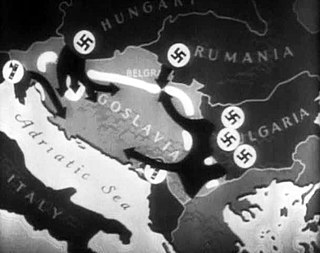
The Yugoslav order of battle before the invasion of Yugoslavia includes a listing of all operational formations of the Royal Yugoslav Army, Royal Yugoslav Army Air Force and Royal Yugoslav Navy immediately prior to the World War II invasion of that country in April 1941.

In late 1937, the Royal Yugoslav Air Force placed an order with Hawker Aircraft for twelve Hawker Hurricane Mk I fighters, the first foreign purchase of the aircraft. The VVKJ operated the British Hawker Hurricane Mk I from 1938 to 1941. Between 1938 and 1940, the VVKJ obtained 24 Hurricane Mk Is from early production batches, marking the first foreign sale of the aircraft. Twenty additional aircraft were built by Zmaj under licence in Yugoslavia. When the country was drawn into World War II by the German-led Axis invasion of April 1941, a total of 41 Hurricane Mk I's were in service as fighters. They achieved some successes against Luftwaffe aircraft, but all Yugoslav Hurricanes were destroyed or captured during the 11-day invasion.














